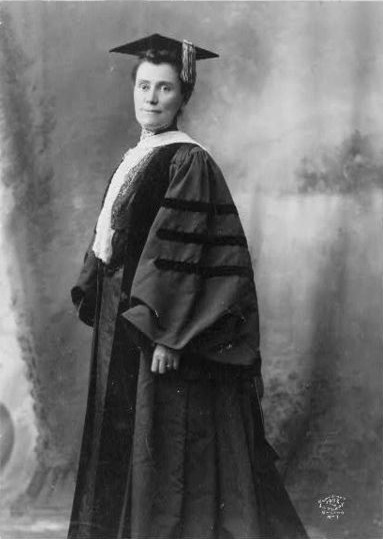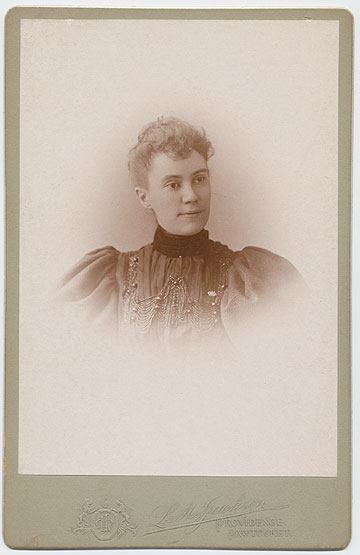<Back to Index>
- Educator Mary Emma Woolley, 1863
- Writer Isaak Emmanuilovich Babel, 1894
- Prime Minister of Denmark Anker Jørgensen, 1922
PAGE SPONSOR


Mary Emma Woolley (July 13, 1863 – September 5, 1947) was an American educator, peace activist and women's suffrage supporter. She was the first female student to attend Brown University and served as the 11th President of Mount Holyoke College from 1900 - 1937.
Woolley was the daughter of Joseph Duah Woolley and his second wife, Mary Augusta Ferris. She was given the nickname May, and enjoyed a comfortable, nurturing childhood in New England. She was first raised in Meriden, Connecticut, and starting in 1871, Pawtucket, Rhode Island. Her father was a Congregational minister and his efforts to incorporate social work into religion, heavily influenced his daughter.
Woolley attended Providence High School and a number of smaller schools run by women before finishing her secondary schooling in 1884 at the Wheaton Seminary in Norton, Massachusetts.
Woolley returned to teach there from 1885 to 1891. After traveling
through Europe for two months during the summer of 1890, she intended
to attend Oxford University, but Elisha Benjamin Andrews, the president of Brown University,
convinced Woolley to become the first female student at Brown. She
began attending Brown in the Fall of 1890, while still teaching at
Wheaton. In 1894, she received her B.A. and in 1895, her M.A. for her
thesis titled, "The Early History of the Colonial Post Office." In 1895, Woolley began teaching biblical history and literature at Wellesley College.
She was popular among her students and peers and in 1896 she was made
an associate professor. By 1899, she had been promoted to a full
professor. During her time at Wellesley, she made significant changes
in the curriculum while gaining administrative experiences as the chair
of her department. She also met Professor Jeannette Marks at Wellesley, and the two women lived in a lesbian relationship for fifty-five years. In December, 1899, Brown offered her a job as the head of the newly founded Women's College. Simultaneously, Mount Holyoke College offered
her its presidency. Woolley took Mount Holyoke's offer and on January
1, 1901, at the age of 38, became one of the youngest college
presidents in the United States. Immediately
upon arrival at Mount Holyoke, Woolley outlined her views on female
education. While in the past, the college had placed an emphasis on
women's education in service to society, Woolley stressed that in the
future, a women's education would not need to be justified by anything
but intellectual grounds. Woolley believed education, roughly, was a
preparation for life, and that an educated woman was able to achieve
anything. She argued that if women had not succeeded in the past, it
was because their education, or lack thereof, had held them back. As
the president of a women's college, one of her many responsibilities
was to publicly support female education. During her 36 year
presidency, she worked to end the prejudice of the era that contended
that women had a natural learning disability and that intellectual work
negatively affected their health. Woolley began to have influence
within the academic community, and she led cooperative efforts with
other women's colleges to raise funds, academic standards and public
consciousness for women's education. During Woolley's presidency, Mount
Holyoke became one of the best colleges in the United States after she
built a strong faculty, attracting scholars from the most prestigious
graduate schools by offering increased salaries, fellowships and
sabbaticals. Woolley
also attempted to improve the quality of students admitted to Mount
Holyoke, after raising admission standards, introducing honors programs
and general examinations for seniors. The college endowment also grew
from $500,000 to nearly $5 million and the campus added sixteen new
building during her 36 year presidency. One of her most significant
changes came when she abolished the domestic work system, instituted by
the college's founder, Mary Lyon.
When Lyon founded the college in 1837, students were required to cook
and clean for economic reasons, and other women's colleges followed the
example. By 1901, Mount Holyoke was the only women's college with the
system still in place and Woolley thought the system was old fashioned
and an obstacle in her goal of making Mount Holyoke intellectually
equal to male colleges. Woolley
also managed to devote her time to a number of organizations during her
presidency, advocating for social reform of all kinds, including
suffrage, pacifism and church matters. She served as the vice president
of the American Civil Liberties Union (ACLU) and also worked on U.S. entry into the League of Nations. She also worked with President Herbert Hoover on women's rights and with President Franklin D. Roosevelt on pacifism. She gained international recognition after President Hoover appointed her as a delegate to the Conference on Reduction and Limitation of Armaments, which met in Geneva, Switzerland, in 1932. Woolley
retired in 1937 at the age of seventy-four and after trustees at Mount
Holyoke were displeased with her outside activities, a male successor, Roswell Gray Ham was
appointed. This greatly disappointed Woolley, and she argued that if a
man was a president for a women's college, it implied that no qualified
female candidate existed, thus the schools goals of preparing women for
positions of responsibility and leadership are diminished. After her
retirement, Woolley never visited the Mount Holyoke campus again. Woolley
remained an active social advocate during her retirement, and she spent
much of her time lecturing at meetings and conferences. On September
30, 1944, in her Westport, New York home, she suffered from a cerebral hemorrhage which
partially paralyzed her. She spent the final three years of her life in
a wheelchair and Marks cared for her until her death in 1947.